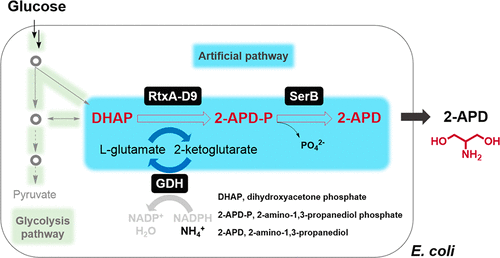当前位置:
X-MOL 学术
›
ACS Synth. Biol.
›
论文详情
Our official English website, www.x-mol.net, welcomes your
feedback! (Note: you will need to create a separate account there.)
An Artificial Biosynthetic Pathway for 2-Amino-1,3-Propanediol Production Using Metabolically Engineered Escherichia coli
ACS Synthetic Biology ( IF 3.7 ) Pub Date : 2019-02-19 00:00:00 , DOI: 10.1021/acssynbio.8b00466 Yuchang Luo 1 , Qinqin Zhao 1 , Qian Liu 1 , Yan Feng 1, 2
ACS Synthetic Biology ( IF 3.7 ) Pub Date : 2019-02-19 00:00:00 , DOI: 10.1021/acssynbio.8b00466 Yuchang Luo 1 , Qinqin Zhao 1 , Qian Liu 1 , Yan Feng 1, 2
Affiliation

|
2-Amino-1,3-propanediol (2-APD) is a chemical building block for the production of various value-added pharmaceuticals. However, the current manufacture of 2-APD predominantly relies on chemical processes by utilizing fossil fuel-derived and highly explosive raw materials. Herein, we established an artificial biosynthetic pathway for converting glucose to 2-APD in a metabolically engineered Escherichia coli. This artificial pathway employs an engineered heterogeneous aminotransferase RtxA for diverting dihydroxyacetone phosphate to generate 2-APD phosphate and an endogenous phosphatase for converting it into the target product 2-APD. Through fine-tuning the activity and solubility of RtxA for efficiently extending the glycolysis pathway, enhancing the metabolic recycling of amino-containing substrate supply via nitrogen-borrowing, and unlocking the dephosphorylation involved in the downstream pathway, the best metabolically engineered E. coli strain LYC-5 was constructed stepwise. Under aerobic conditions, a fed-batch fermentation of the strain LYC-5 produced 14.6 g/L 2-APD with a productivity of 0.122 g/L/h in a 6-L bioreactor, which was the highest reported titer to the best of our knowledge. This work demonstrates the great potential to provide an environmentally friendly and efficient approach for 2-APD production.
中文翻译:

代谢工程化大肠杆菌生产2-氨基-1,3-丙二醇的人工生物合成途径
2-氨基-1,3-丙二醇(2-APD)是生产各种增值药品的化学基础。但是,当前的2-APD生产主要依靠利用化石燃料衍生的高爆炸性原材料的化学过程。在本文中,我们建立了在代谢工程化的大肠杆菌中将葡萄糖转化为2-APD的人工生物合成途径。该人工途径采用工程化的异质氨基转移酶RtxA转移磷酸二羟基丙酮生成2-APD磷酸,并使用内源性磷酸酶将其转化为目标产物2-APD。通过微调RtxA的活性和溶解度,以有效地扩展糖酵解途径,增强含氨基底物供应的代谢循环通过氮的吸收并释放下游途径中涉及的去磷酸化作用,逐步构建了最佳的代谢工程大肠杆菌菌株LYC-5。在有氧条件下,LYC-5菌株的分批分批发酵在6-L生物反应器中产生了14.6 g / L 2-APD,生产率为0.122 g / L / h,这是报道的最高滴度至最佳滴度。我们的知识。这项工作证明了为2-APD生产提供环保和高效方法的巨大潜力。
更新日期:2019-02-19
中文翻译:

代谢工程化大肠杆菌生产2-氨基-1,3-丙二醇的人工生物合成途径
2-氨基-1,3-丙二醇(2-APD)是生产各种增值药品的化学基础。但是,当前的2-APD生产主要依靠利用化石燃料衍生的高爆炸性原材料的化学过程。在本文中,我们建立了在代谢工程化的大肠杆菌中将葡萄糖转化为2-APD的人工生物合成途径。该人工途径采用工程化的异质氨基转移酶RtxA转移磷酸二羟基丙酮生成2-APD磷酸,并使用内源性磷酸酶将其转化为目标产物2-APD。通过微调RtxA的活性和溶解度,以有效地扩展糖酵解途径,增强含氨基底物供应的代谢循环通过氮的吸收并释放下游途径中涉及的去磷酸化作用,逐步构建了最佳的代谢工程大肠杆菌菌株LYC-5。在有氧条件下,LYC-5菌株的分批分批发酵在6-L生物反应器中产生了14.6 g / L 2-APD,生产率为0.122 g / L / h,这是报道的最高滴度至最佳滴度。我们的知识。这项工作证明了为2-APD生产提供环保和高效方法的巨大潜力。






























 京公网安备 11010802027423号
京公网安备 11010802027423号